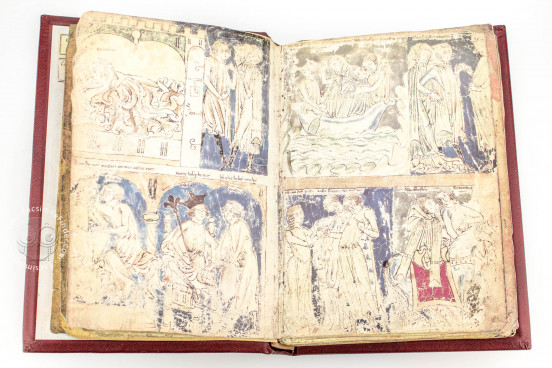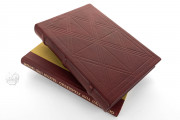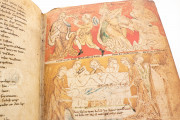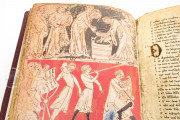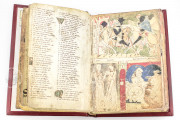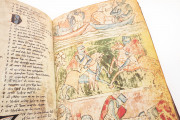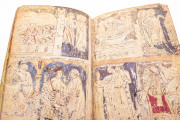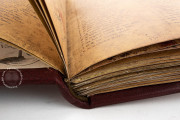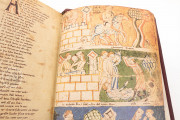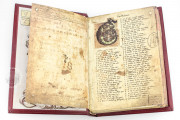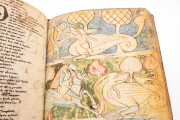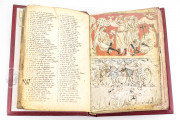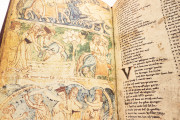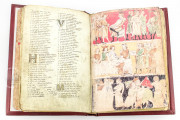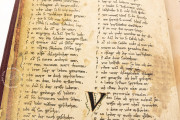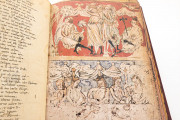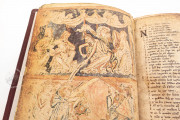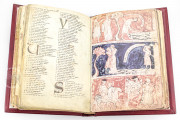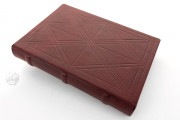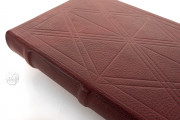The Munich manuscript of the Romance of Tristan and Isolde, written and illuminated toward the middle of the thirteenth century, contains Gottfried von Strassburg's Arthurian tale. It is the earliest surviving copy of the poem. The tragic story of the two lovers is considered a key contributor to the Western notion of romantic love. The manuscript, produced in either France or Southern Germany, boasts thirty pages (fifteen leaves painted front and back) of stylistically dynamic figural illustrations on colored backgrounds, with each full-page miniature having two or three horizontal registers.
The text, which has suffered substantial losses, comprises abridged versions of the Tristan story by Gottfried and its continuation by Ulrich von Türheim. The manuscript dates from within a generation of the composition of the text.
Fighting, Feasting, and Lovemaking
The miniatures are the work of at least two and probably more artists, and overpainting makes identifying the work of individuals difficult to assess. All are essentially drawings, most with colored backgrounds (of red, pink, blue, green, yellow, or beige). Isolated details, such as crowns, are rendered in gold. The first six miniatures are divided into two registers, and the remaining are in three registers.
The subjects of the miniatures include battles between mounted armies (e.g., fols. 10r and 37r), a duel (fol. 46r), and the slaying of a dragon (fol. 67r). Courtly pastimes, such as dancing, music-making, jousting, and hunting, are also pictured (e.g., fols. 7r, 30v, and 101v). The eponymous lovers are pictured kissing (fol. 76r) and more than once in bed together (e.g., fol. 101v).
The Story in Verse and Pictures
The narrative unfolds in the manuscript twice, in the text and, quite separately, in a series of paintings interspersed through the text. The miniatures, each of which contains more than one scene, occupy the recto and verso (front and back) of leaves created separately from the text. These picture leaves appear at irregular intervals, with as few as two and as many as twenty leaves separating them. It is unknown whether this reflects the medieval arrangement, and at least one leaf with miniatures has been lost.
Pictures of Enduring Interest
The miniatures, which initially appeared without captions or inscriptions, immediately attracted attention, and various scribes writing in the second half of the thirteenth century through the early fourteenth century added labels identifying people and scenes.
Decorative Golden Initials
The text's rhyming couplets were written almost entirely by a single scribe in two columns in Gothic Hybrida script, with the opening letter of each line set off in the left margin. This scribe was also the principal scribe of the Munich Parzifal.
The enlarged gold initials divide the text neither according to the sense of the narrative nor the poetic form. They create regular patterns, usually with three initials per page, one in the first column and two in the second, yielding sections of comparable length.
In Bavaria in the Middle Ages
The manuscript's early history is untraced, although the dialect of some of the early annotations suggests that it was in Bavaria not long after it was made. It is first recorded in the Hofbibliothek of Wilhelm V (1548-1626), Duke of Bavaria, in 1582. The holdings of the Hofbibliothek formed the foundation collection of the Hof- und Staatsbibliothek in 1829, which was renamed the Bayerische Staatsbibliothek in 1919. The current binding of stamped leather over pasteboard dates from the mid-nineteenth century.
We have 1 facsimile edition of the manuscript "Romance of Tristan and Isolde by Gottfried von Strassburg": Gottfried von Strassburg: Tristan und Isolde facsimile edition, published by Mueller & Schindler, 1979
Request Info / Price
